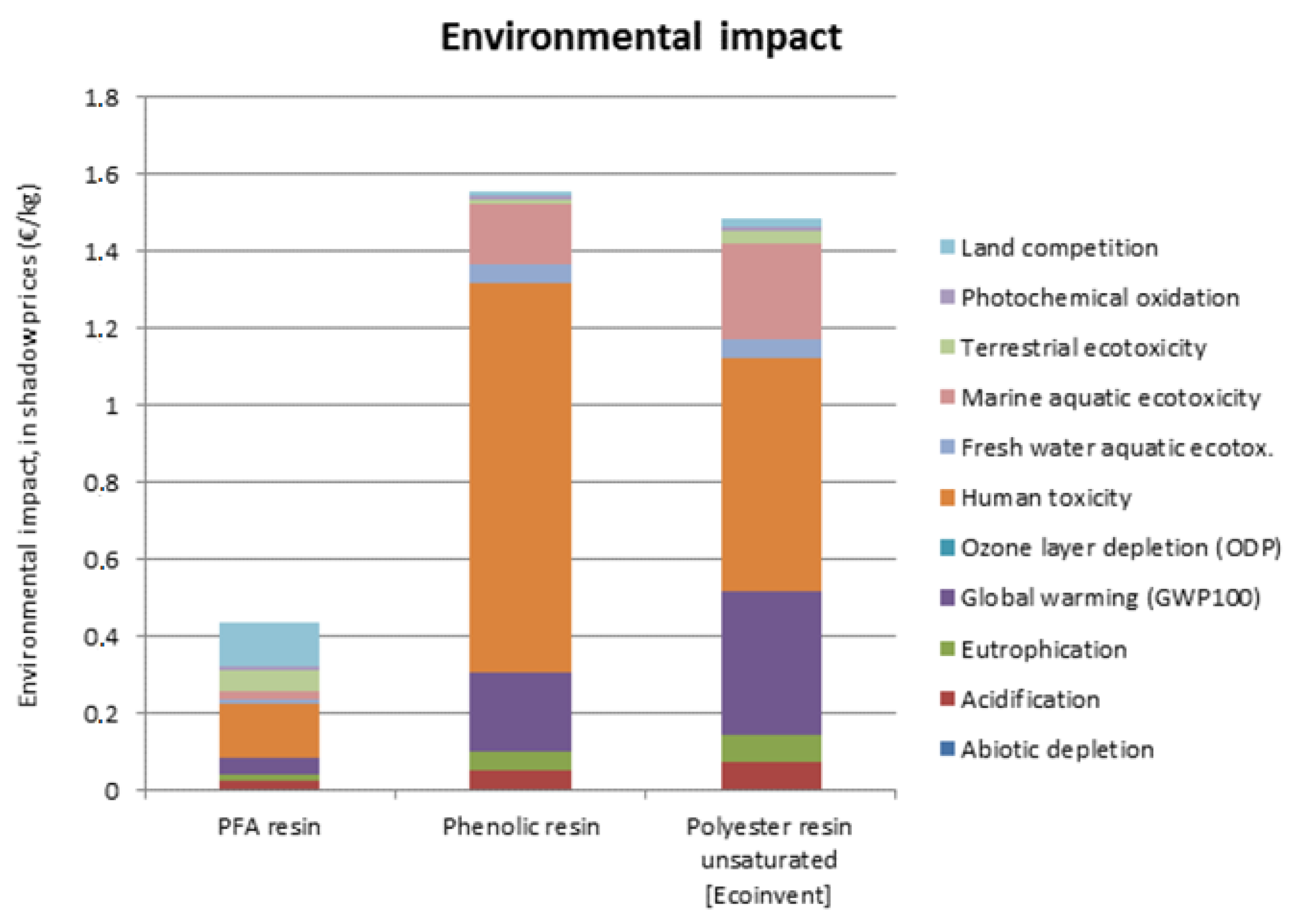IPC-TM-650 Screening Tests
The copper cores fabricated as per
Section 2.3.3 were tested by IPC-TM-650 test methods. The test results are summarized in
Table 6 below. The target values were based on a pre-existing high-performance FR4.
The thermal stress specimens were conditioned at 125 °C for 6 h and floated for 10 s on a solder bath at 288 °C. All specimens, both clad and etched, exhibited delamination and blistering, as shown in
Figure 13. This was a result of void formation inside the laminate as the reaction was initiated, and condensate was generated in the material at the test temperature of 288 °C. The etched specimens show that the blister formation occurs within the composite itself and not just between the composite and the copper. However, since this test exposes the material to higher thermal stress than any process during PCB manufacture, it was still possible that the prototype boards would be capable of surviving the manufacturing process. To aid in reducing the thermal stress on the prototypes, the electroless nickel immersion gold (ENIG) plating process, which only requires temperatures up to 80 °C, was used instead of the hot air solder level (HASL) process, which requires temperatures up to 255 °C. As a result, the step in the prototyping process that correlated with the highest thermal stress became the solder reflow step during assembly. This step reaches a maximum temperature of 255 °C, the highest the prototype is expected to face during its lifetime. Since this is still considerably lower than the thermal stress test temperature, the assembly process was expected to lead to small-scale void formation but would avoid the degree of blistering observed in the thermal stress specimens.
The water absorption values were significantly higher than the target values. This was likely due to the high void contents in the laminate, which were generated during the final bonding stage of the copper cores. During this stage, the volatiles that were generated no longer had any means of escaping the laminate as the bulk of the laminate was already cured and the outer faces were sealed by copper. Furthermore, the water absorption testing was performed on laminates that had the copper cladding etched off; consequently, any voids that formed between the copper and the AX-3450 at the laminate surface were exposed to the moisture, which led to the diffusion of the water into the laminate. This high water absorption is perhaps the most concerning challenge for the use of PFA in PCBs, as water absorption can affect a variety of material properties that are key to PCB performance, such as resistivity, dielectrics, and continuity.
The volume resistivity values were significantly lower than the target FR4 values. This is believed to be due to the water absorption and generation that occurred in the material. In the case of epoxies, the more water absorbed into the matrix, the less resistant the material will become [
19]. Assuming similar effects of moisture on the resistivity in PFA, the high resistivity values at room temperature were a result of the high moisture absorption. Due to dielectric breakdown, the surface resistivity after water absorption was not measurable at room temperature. A decrease in resistivity at elevated temperatures was also observed. While this was expected, it is possible that the conditioning at 125 °C for 24 h also initiated a condensation reaction, thus causing the release of additional moisture within the material.
The peel values in both standard and after thermal stress conditions were roughly half of the target values, while the peel values after fluid exposure were comparable to the target values. These properties were likely affected by the condensation reaction during curing. When the single-sided laminates are cured, the copper-free prepreg face provides an avenue for volatiles to escape; however, once the material is cured, the breathing path for volatiles to escape the laminate is cut off. During the cure of the final assembly, the volatiles closer to the copper face had no means of escaping the laminate and may have built up between the copper and the PFA at a concentration that was high enough to affect the bonding of the copper without forming visible blisters in the foil due to the high pressure on the laminate.
The permittivity values of AX-3450 were within the target values, while the loss tangent values were higher for all of the frequencies other than 10GHz, which is where the values fall into the target range. The permittivity, or dielectric constant, is a measure of the material’s capacity to store electrical energy; thus, a low permittivity is desirable for insulating materials. The permittivity value of AX-3450 decreases with increasing frequency, which is also expected of FR4. The loss tangent, or dissipation factor, is a measure of the amount of current dissipated by the material, meaning that a material with a lower loss tangent will act as a more favorable dielectric material. The loss tangent of AX-3450 was higher than in FR4 in the low-frequency range. However, while the typical loss tangent value of FR4 increased with increasing frequency, the loss tangent of AX-3450 decreased such that it fell within a range comparable to FR4 at 10 GHz. This is evidence that the dielectric properties of AX-3450 improve with increasing frequency in the GHz range.
While the test results did not meet the target values based on a current, high-performance FR4, the tests performed above presented more extreme conditions than the material would experience in a true PCB manufacturing environment. As such, to learn more about the capabilities of AX-3450, PCB prototypes were manufactured using typical manufacturing methods and tested for functionality as per what is described in the next sections.




















